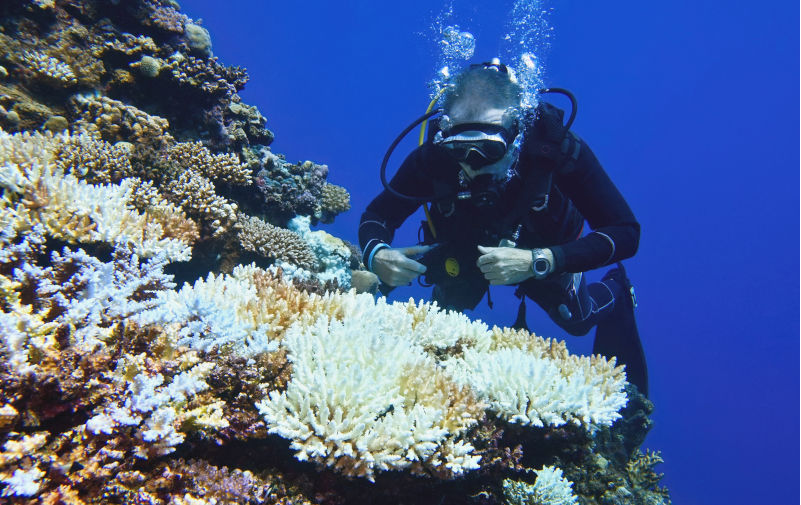The Great Barrier Reef is the litmus test for the forthcoming 2035 emissions reduction target
August 13, 2025
Coral reefs are highly vulnerable to climate change. That’s why, for years, conservationists have advocated that Australia’s climate policy be tied to the future of the Great Barrier Reef.
The Great Barrier Reef is the litmus test for the forthcoming 2035 emissions reduction target. Unless it is aligned with keeping the global average temperature rise to 1.5C, the government cannot claim to be serious about keeping one of the seven natural wonders of the world, and the only one that we’re responsible for, safe.
Last summer, the Reef experienced another mass coral bleaching event – the sixth in the past decade and the second back-to-back event in the same period. These events are becoming alarmingly frequent. But it is not time to give up on the Reef. More than ever, it is time to reel back from the brink and demand a national emissions target that gives the Reef a chance of surviving the next few decades so that recovery can occur in the second half of this century.
Yes, climate change is a global issue, but our government has primary responsibility as the steward of this incredibly complex and beautiful ecosystem to do the right thing by the Reef. As a World Heritage site, the government has a legal duty under the World Heritage Convention to protect, conserve and transmit the Reef to future generations.
Matt Kean, chair of the Climate Change Authority, has a strong view on the matter. He gave an excellent speech about the Reef at the recent Australian Meteorological and Oceanographic Society Summit in Cairns. Soon after, the Climate Change Authority released a report about climate threats to the Great Barrier Reef.
There’s no doubt that by making this speech and releasing this report, the Authority, under Kean’s leadership, is setting the bar for the forthcoming 2035 emissions reduction target in Australia’s Nationally Determined Contribution, to be submitted to the UNFCCC ahead of COP30. The report’s executive summary states:
“Globally, coral reefs are projected to decline by 70 to 90% if climate warming remains at 1.5 °C above pre-industrial levels for an extended period. At 2 °C of warming, up to 99% of corals may be lost or fundamentally altered. In 2024, global temperatures spiked above the 1.5 °C threshold for the first time, highlighting the urgency of action to prevent escalating warming becoming the norm.”
It is a call for a target that will give the Reef a fighting chance. The World Heritage Committee has made the same request. In its Great Barrier Reef decision this year, the 21-nation Committee called on the Australian Government “to set further ambitious targets to limit temperature increases … to 1.5C … and align its policies accordingly”.
If Australia does so, the Great Barrier Reef will not be the only climate-vulnerable ecosystem to benefit. Earlier this year, the World Heritage listed Ningaloo Reef near Exmouth, WA, suffered a severe marine heatwave, the first major coral bleaching event at Ningaloo since 2011-2013. Ningaloo is the world’s largest fringing coral reef and home to dugongs, whale sharks, turtles, manta rays, humpback whales and much more.
The Australian Institute of Marine Science reported that coral bleaching extended across thousands of kilometres from Ningaloo Reef in the south to Ashmore Reef in the far north. Heat stress reached unprecedented levels over five months from December 2024 through to April 2025. It was the first mass bleaching on record on the inshore Kimberley coast, with heat stress there reaching extremely high levels (+3 to 4°C) in January and February.
On the other side of the continent, the Great Barrier Reef was also experiencing a mass bleaching event. Higher than average sea temperatures brought prolonged heat stress for the coral animals in the northern third of the Marine Park.
This year’s event followed a more severe bleaching event last year. On 6 August 2025, AIMS released a final report about the 2024 event on the Great Barrier Reef. The report found coral cover (a measure of how much of the reef’s surface is covered by live hard coral) had declined by almost one third in the southern region of the Marine Park, by one quarter in the northern region, and by 14% in the central region. The sharp losses of coral cover in the northern and southern regions were unprecedented.
These losses had followed a major increase in coral cover in the early years of the 2020s. The sharp declines in 2024 brought coral cover back to near long-term average levels.
While this last fact appears to be good news, the main message from scientists is that the Great Barrier Reef is now a volatile ecosystem. It is unstable. Like an unstable chair, it will collapse at some point unless the problem is fixed. Australia’s 2035 target, due out in September, is the government’s opportunity to fix its part of the problem.
The views expressed in this article may or may not reflect those of Pearls and Irritations.

